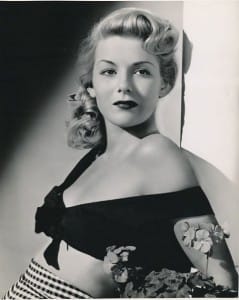
Cindy Garner: Hollywood’s Almost Starlet
Born Dorothy Elizabeth Garner Gray on December 21, 1924, in the small town of Robbins, North Carolina, Cindy Garner was the daughter of Douglas “Duff” and Eula Garner. Before she ever graced the silver screen, she was just a small-town girl with big dreams and a wild imagination—qualities that would carry her far, even if not quite to the heights she envisioned.
Cindy’s first taste of the spotlight came early. In elementary school, she played a buttercup in a school play—an experience that lit a fire in her that never fully went out. But while acting had her heart, writing had her mind. By age 16, she was penning a column called Personality Parade for the High Point Beacon, the local weekly newspaper. Publicists would later dub her “the only newspaper gal who ever hit Hollywood,” and while the claim may be more colorful than true, it did capture the sense of reinvention that followed her throughout her life.
From Small Town to Silver Screen
Cindy’s first break came not on a stage, but in a smoky nightclub. After marrying a soldier and relocating to Los Angeles in 1943, she worked as a cigarette girl at the famed Ciro’s nightclub. It was there that a Hollywood talent scout spotted her, leading to a screen test and a contract as a Goldwyn Girl with Samuel Goldwyn Studios. She rubbed shoulders with glamour and greatness, though few Goldwyn Girls ever made it big. Cindy would not be among the lucky few, but her brief film career still left a fascinating trail.
Her first on-screen appearance came in Up in Arms (1944), followed by another forgettable turn in Show Business. But a small role in Since You Went Away (1944), a David Selznick wartime drama with an all-star cast, gave Cindy a taste of serious cinema. From there, she appeared in You Came Along, A Scandal in Paris, and Till the End of Time—films that ranged from romantic to thought-provoking, but none that truly elevated her beyond bit roles.
By 1946, the dream had stalled. Cindy turned to modeling, becoming a regular face in magazines like Esquire, Modern Romance, and Hit. She also performed for troops at army bases, still hoping for another shot at acting.
Reinvention and a Second Chance
In 1951, Cindy got that second chance. Universal International offered her a seven-year contract, rewriting her story for the press: she was now a fresh face, a model-turned-actress recently arrived in Los Angeles. Her early screen credits? Quietly forgotten. Her first marriage? Omitted. Hollywood loved a good narrative, and Cindy was more than willing to play the part.
She appeared in lighthearted fare like Week-End with Father and Meet Danny Wilson, the latter starring Frank Sinatra and Shelley Winters. In Flame of Araby, she joined Maureen O’Hara and Jeff Chandler in a sweeping desert epic, while her first credited performance came in Red Ball Express, a World War II film that highlighted the behind-the-lines efforts of Allied truck convoys. Her final screen role was in Ma and Pa Kettle at Waikiki, which premiered after her departure from Hollywood.
Life Beyond the Limelight
Cindy’s off-screen life was just as dramatic as anything Hollywood could script. After divorcing her first husband, she married a man named Marshall in 1946 and had a daughter, Cathy Jo, in 1948. But by the early 1950s, Cindy was living alone in North Hollywood, working hard during the week and spending weekends entertaining troops at airbases. She was athletic, artistic, a lover of poetry, and proud of her Southern roots—traits that made her both relatable and unique in the image-obsessed world of Hollywood.
Despite her efforts, Cindy’s film career never truly caught fire. Universal let her go in 1952, and by 1955, she had made her final (uncredited) film appearance. Her marriage ended, and life took a difficult turn. Suffering from mental health struggles and now a single mother, Cindy returned to North Carolina in 1954. Her daughter went to live with relatives while Cindy received care from her mother and, later, in mental health facilities. She underwent electroshock treatments and struggled to regain her footing.
And yet, Cindy persevered.
A Quiet Resilience
Eventually, she recovered. In the 1960s or ’70s, she married again—this time to Jerry Gray, a man eleven years her junior. They lived together in High Point, North Carolina, until their divorce sometime after 1992. Despite life’s hardships, Cindy continued to embrace the everyday joys: painting, reading, caring for her beloved black cat, and staying active in the outdoors.
Dorothy Elizabeth Garner Gray—known to the world, if briefly, as Cindy Garner—passed away on January 2, 2002, in Sanford, North Carolina. Her story is one of ambition, reinvention, resilience, and quiet determination. She may not have become a Joan Crawford or a Lois Lane, but she carved out a life of her own, full of fascinating chapters and unforgettable scenes.

